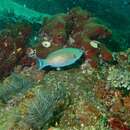Diagnostic Description
provided by Fishbase
Males differ slightly in head pattern and differences most obvious in females with yellow or red anal fins (Ref. 48636). Terminal phase similar to S. forsteni, differing primarily by having a yellow inner pectoral axil (Ref. 37816).
- Recorder
- Cristina V. Garilao
Life Cycle
provided by Fishbase
Oviparous, distinct pairing during breeding (Ref. 205).
Morphology
provided by Fishbase
Dorsal spines (total): 9; Dorsal soft rays (total): 10; Analspines: 3; Analsoft rays: 9
- Recorder
- Cristina V. Garilao
Trophic Strategy
provided by Fishbase
Inhabits lagoon and seaward reefs, in areas with dense coral growth up to at least 30 m. Feeds on benthic algae (Ref. 9710).
- Recorder
- Drina Sta. Iglesia
Biology
provided by Fishbase
Inhabits lagoon and seaward reefs, in areas with dense coral growth (Ref. 9710) up to at least 30 m. Usually solitary, sometimes in groups (Ref. 9710). Feeds on benthic algae (Ref. 3488).
- Recorder
- Estelita Emily Capuli
Importance
provided by Fishbase
fisheries: commercial; aquarium: commercial
- Recorder
- Estelita Emily Capuli
Comprehensive Description
provided by Smithsonian Contributions to Zoology
Scarus cyanognathus Bleeker
Scarus cyanognathos Bleeker, 1849, p. 63.
Pseudoscarus cyanognathos.—Bleeker, 1862, p. 32, pl. 11: fig. 2.
Callyodon cyanognathos.—Smith, 1959, p. 279, pl. 42K.—Munro, 1967, p. 441, fig. 842 [New Guinea].
Callyodon pectoralis [not Cuvier and Valenciennes].—Smith, 1956, p. 15, pl. 42J.
Callyodon urbanus Smith, 1959, p. 272, pl. 42J.
Characterized by 6 or 7 predorsal scales, 3 rows of scales on cheek with 3 or 5 scales in ventral row, and ii,12 pectoral rays; green or blue teeth when adult; dorsal fin with blue edge, the broad center orange, sometimes a green streak at middle, and base narrowly blue; anal with color pattern same as the dorsal fin. Blue streak from snout past lower edge of eye; upper lip pink, lower with blue edge; middle of pectoral fin purple, upper edge blue or green; underside of head with two blue bars behind blue lip, separated by yellow.
I examined Bleeker”s type of S. cyanognathus in the British Museum (Catalog no. 1862.2.28.4, standard length 182 mm) and found 6 predorsal scales, ii,12 pectoral rays, and the upper row of cheek scales numbered 7 and 7, middle row 7 and 8, and ventral row 4 and 5, upper lip pale, with a darker streak from snout past lower edge of eye as shown in Bleeker (1862, pl. 11: fig. 2). Scarus cyanognathos Bleeker, 1849 (p. 63; also 1862, pl. 11: fig. 2), appears to be valid and is not a synonym of S. pectoralis=S. oviceps as indicated by Schultz (1958, p. 100).
Randall (1963, pp. 225–237) has shown that Scarus pectoralis Cuvier and Valenciennes is the female of S. oviceps; and an examination of the type of Callyodon lazulinus Jordan and Seale and that of C. elerae Jordan and Seale has revealed that these nominal species are junior synonyms of S. oviceps. Callyodon lazulinus Smith, 1956 (pl. 42K) (=C. cyanognathus Smith, 1959, pl. 42K), is Scarus oviceps. Callyodon urbanus Smith, 1959 (p. 272, pl. 42J), appears to be the same as S. cyanognathos Bleeker. Smith’s figure shows a yellow bar at base of pectoral. Obviously the species involved here needs a further investigation.
RANGE.—Western Pacific Ocean and Indian Ocean.
- bibliographic citation
- Schultz, Leonard P. 1969. "The taxonomic status of the controversial genera and species of parrotfishes with a descriptive list (family Scardiae)." Smithsonian Contributions to Zoology. 1-49. https://doi.org/10.5479/si.00810282.17
Scarus tricolor: Brief Summary
provided by wikipedia EN
Scarus tricolor, also known as the tri-colour parrotfish or three-coloured parrotfish, is a species of marine ray-finned fish, a parrotfish, in the family Scaridae. It has a wide Indo-Pacific distribution.
- license
- cc-by-sa-3.0
- copyright
- Wikipedia authors and editors
Description
provided by World Register of Marine Species
Inhabits outer reef slopes to at least 30 m. Feeds on benthic algae (Ref. 3488).
Froese, R. & D. Pauly (Editors). (2023). FishBase. World Wide Web electronic publication. version (02/2023).
- license
- cc-by-4.0
- copyright
- WoRMS Editorial Board

